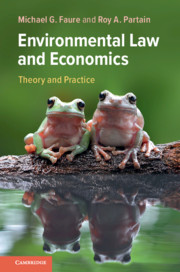Book contents
- Environmental Law and Economics
- Environmental Law and Economics
- Copyright page
- Contents
- Preface
- Acknowledgements
- Abbreviations
- 1 Introduction
- 2 Environmental Harm and Efficiency
- 3 Property Rights Approach to Environmental Law
- 4 Environmental Standard Setting
- 5 Principles of Environmental Law and Environmental Economics
- 6 Pricing Environmental Harm
- 7 Market-Based Instruments
- 8 Liability Rules
- 9 Environmental Regulation
- 10 Environmental Crime
- 11 Insurance for Environmental Damage
- 12 Compensation for Environmental Damage
- 13 Environmental Federalism
- 14 The Role of Environmental Law in Developing Countries
- 15 Epilogue
- References
- Index
12 - Compensation for Environmental Damage
Published online by Cambridge University Press: 13 September 2019
- Environmental Law and Economics
- Environmental Law and Economics
- Copyright page
- Contents
- Preface
- Acknowledgements
- Abbreviations
- 1 Introduction
- 2 Environmental Harm and Efficiency
- 3 Property Rights Approach to Environmental Law
- 4 Environmental Standard Setting
- 5 Principles of Environmental Law and Environmental Economics
- 6 Pricing Environmental Harm
- 7 Market-Based Instruments
- 8 Liability Rules
- 9 Environmental Regulation
- 10 Environmental Crime
- 11 Insurance for Environmental Damage
- 12 Compensation for Environmental Damage
- 13 Environmental Federalism
- 14 The Role of Environmental Law in Developing Countries
- 15 Epilogue
- References
- Index
Summary
This chapter covered financial tools beyond conventional insurance, to cover self-insurance, risk-sharing agreements, forms of deposits, and various types of compensation funds. The common element is that the capital either remains solely with the actor or remains closer to the actor, so they are less costly on capital budgets. Self-insurance meant to book a financial reserve to cover certain future risks. In the late 1970s, the term began to include the concept of ‘captives,’ wherein a company owns its own insurance agency and write its own policies. Risk-sharing agreements are contractual agreements between similarly placed firms to agree to pay-up in capital, based on a pre-agreed ratio, to cover any of the co-parties’ capital needs to cover emergencies and damages. Various forms of deposits and guarantees involve a third party holding the capital of the risky first party until a certain event or time period has been successfully reached; however, this type of structure can create substantial moral hazards. Compensation funds can be created in two basic manners, the first is to have the actor pay while undertaking the risky activity in some form, while the second is to have public funds cover the cost of the funds.
- Type
- Chapter
- Information
- Environmental Law and EconomicsTheory and Practice, pp. 253 - 274Publisher: Cambridge University PressPrint publication year: 2019



